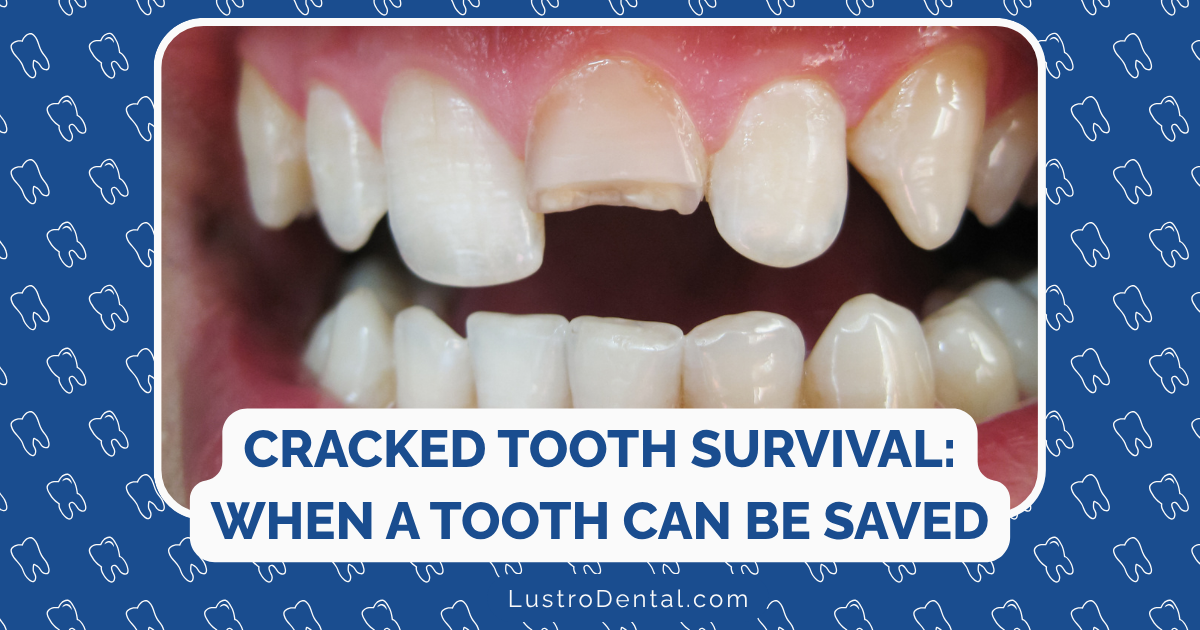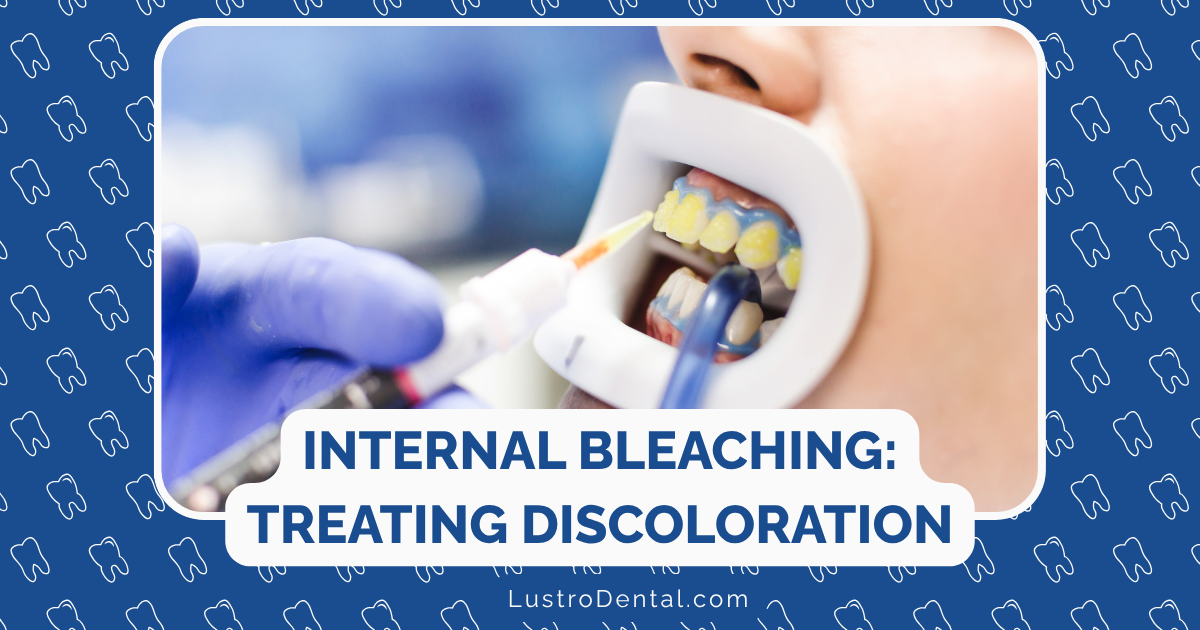Saving Cracked Teeth: When It’s Possible and When It’s Not

The moment you discover your tooth is cracked can be anxiety-inducing. The uncertainty of whether your natural tooth can be saved—and what happens if it can’t—weighs heavily on many patients I’ve counseled through the years.
The good news? Modern dentistry has made remarkable advances in saving cracked teeth. Studies show that with proper treatment, many cracked teeth can be preserved for decades with success rates as high as 90-96%. However, not every cracked tooth can be saved, and understanding the difference is crucial for making informed decisions about your dental health.
In this guide, I’ll walk you through the factors that determine whether a cracked tooth can be saved, what the latest research tells us about success rates, and what your options are when saving the tooth isn’t possible.
The Science of Saving: What Research Tells Us
Before diving into specific scenarios, let’s look at what the latest dental research reveals about cracked tooth survival:
- According to the American Association of Endodontists, the overall survival rate for properly treated cracked teeth at 5 years is approximately 84%.
- Cracked teeth that receive root canal treatment followed by a full crown have survival rates between 94-96% at 2 years.
- Even teeth with cracks extending into the root (previously thought to be unsalvageable) can have success rates up to 91% with appropriate treatment.
Dr. Sarah Johnson, endodontist at University Dental Institute, explains: “What’s exciting about recent research is that we’re finding teeth we once thought were hopeless can actually be saved with modern techniques. The key is accurate diagnosis and appropriate treatment planning.”
Factors That Determine If Your Cracked Tooth Can Be Saved
Several critical factors influence whether your cracked tooth can be preserved:
1. Type and Extent of the Crack
Different types of cracks have different prognoses:
Likely Salvageable:
- Craze lines: These superficial cracks affect only the enamel and don’t require treatment beyond possible cosmetic procedures.
- Fractured cusps: When a piece of the chewing surface breaks off but doesn’t extend deeply, the tooth can usually be saved with a crown or onlay.
- Cracked tooth (early stage): Vertical cracks that haven’t extended below the gumline can typically be saved with appropriate treatment.
Questionable Prognosis:
- Cracked tooth (advanced): Cracks extending below the gumline but not completely through the root have a guarded prognosis—some can be saved, others cannot.
- Cracked tooth with deep periodontal pocket: Research shows that teeth with crack-associated periodontal pockets deeper than 5mm have lower success rates (around 83% vs. 92% for shallower pockets).
Poor Prognosis:
- Split tooth: When a crack has completely divided the tooth into separate segments, the entire tooth typically cannot be saved, though portions may be salvageable in some cases.
- Vertical root fracture: These cracks begin in the root and extend upward, usually requiring extraction.
2. Pulpal Involvement and Symptoms
The condition of your tooth’s pulp (the inner tissue containing nerves and blood vessels) significantly impacts prognosis:
- Normal pulp or reversible pulpitis: Teeth with healthy pulp or mild, reversible inflammation have excellent chances of being saved (success rates >90%).
- Irreversible pulpitis: When the pulp is severely inflamed but not yet infected, root canal therapy can still save the tooth with success rates around 85%.
- Pulp necrosis (death): Teeth with dead pulp tissue due to cracks have lower success rates (approximately 80%), but many can still be saved.
- Previously treated teeth: Cracked teeth that have already had root canal treatment have the lowest success rates (around 74%), but saving them is still possible in many cases.
3. Location of the Tooth
The position of the affected tooth in your mouth matters:
- Front teeth: Generally experience less biting force and may have better outcomes even with significant cracks.
- Premolars: Subject to moderate forces and often have favorable outcomes when properly treated.
- Molars: Experience the highest biting forces and are most susceptible to crack propagation, potentially lowering success rates.
Dr. Michael Chen of Advanced Dental Specialists notes, “Molar teeth, particularly mandibular (lower) molars, are the most commonly cracked teeth we see. They also present the greatest challenge due to the extreme forces they endure during chewing.”
4. Timeliness of Treatment
Perhaps the most critical factor in saving a cracked tooth is how quickly you seek treatment:
- Early intervention for cracked teeth with minimal symptoms can prevent pulp involvement, often eliminating the need for root canal therapy.
- According to a 2024 study in the Compendium of Continuing Education in Dentistry, only one in five cracked teeth with early treatment eventually requires root canal therapy.
- Delaying treatment allows cracks to propagate deeper, significantly reducing the chances of saving the tooth.
The Treatment Timeline: Critical for Success
The sequence and timing of treatment significantly impact whether a cracked tooth can be saved:
Immediate Protection
For a recently cracked tooth:
- Temporary crown or orthodontic band placement can prevent crack propagation
- Avoiding chewing on the affected side
- Addressing any grinding or clenching habits that could worsen the crack
Definitive Treatment
Depending on the diagnosis, treatment may include:
For Cracks Without Pulp Involvement:
- Direct composite bonding for minor cracks
- Onlay or crown placement to protect and stabilize the tooth
For Cracks With Pulp Involvement:
- Root canal therapy to remove damaged pulp tissue
- Placement of intraorifice barriers (special materials placed within the tooth after root canal) to strengthen the tooth
- Full crown placement ideally within 2-4 weeks of root canal completion
Dr. Lisa Wong, Director of Endodontic Research Institute, emphasizes, “The placement of a full crown after endodontic treatment is absolutely critical. Studies show that cracked teeth without crowns have only a 20% survival rate at 2 years, compared to 94% for those with crowns.”
When Saving the Tooth Is Not Possible: Understanding Your Options
Despite our best efforts, some cracked teeth simply cannot be saved. According to the American Association of Endodontists, extraction is typically recommended when:
- The crack extends across the floor of the pulp chamber
- The tooth shows signs of being split into separate segments
- The crack extends far below the gumline, making it impossible to restore
- There is extensive bone loss around the crack
- Previous attempts to save the tooth have failed
When extraction becomes necessary, modern tooth replacement options offer excellent alternatives:
Dental Implants
Advantages:
- Success rates exceeding 95% at 10 years
- Preserves jawbone and facial structure
- Functions like a natural tooth
- Doesn’t affect adjacent teeth
Considerations:
- Higher initial cost ($3,000-$5,000 per tooth)
- Requires adequate bone volume
- Treatment time of 3-6 months or longer
Fixed Bridges
Advantages:
- Completed in 2-3 weeks
- Lower initial cost than implants
- Natural appearance
- Fixed in place (not removable)
Considerations:
- Requires alteration of adjacent teeth
- Typical lifespan of 10-15 years
- May contribute to bone loss in the extraction site
Removable Partial Dentures
Advantages:
- Most affordable option
- Non-invasive to other teeth
- Can replace multiple missing teeth
Considerations:
- Less stable than fixed options
- May accelerate bone loss
- Visible clasps may affect aesthetics
Making the Decision: Clinical Factors vs. Personal Considerations
While clinical factors are essential in determining whether a tooth can be saved, personal considerations also play a significant role in the decision-making process:
Clinical Factors:
- Type and extent of the crack
- Pulpal and periodontal condition
- Restorability of the remaining tooth structure
- Overall oral health and adjacent teeth
Personal Considerations:
- Cost and insurance coverage: Saving a severely compromised tooth might require multiple procedures (root canal, crown lengthening, post and core, crown) potentially costing $3,000-$4,000, similar to the cost of an implant but with a less certain outcome.
- Treatment timeline: Root canal therapy and crown placement typically require 2-3 appointments over several weeks, while implant treatment may take 3-6 months or longer.
- Personal value placed on natural teeth: Some patients strongly prefer keeping their natural teeth when possible, even with a guarded prognosis.
- Long-term dental goals: Your overall treatment plan and expectations for dental health should be considered.
Dr. Johnson advises, “I always have an honest conversation with my patients about the prognosis. If the chance of saving a tooth is below 70%, we carefully weigh whether the investment of time and money might be better directed toward a more predictable long-term solution like an implant.”
Case Examples: When to Save and When to Extract
To illustrate these principles, let’s look at some common scenarios:
Case 1: Likely Salvageable
Scenario: 45-year-old with a cracked lower molar, crack visible on the chewing surface, mild sensitivity to cold, no pain on biting, no periodontal pockets.
Recommendation: Crown placement without root canal therapy.
Prognosis: Excellent (>90% success rate at 5 years).
Case 2: Questionable Prognosis
Scenario: 60-year-old with a cracked upper premolar, crack extending below gumline, pain on biting, 4mm periodontal pocket associated with the crack, pulp tests vital.
Recommendation: Root canal therapy followed by crown placement.
Prognosis: Good but guarded (approximately 85% success rate at 5 years).
Case 3: Poor Prognosis
Scenario: 55-year-old with a cracked lower molar, crack visible extending onto root surface, 7mm periodontal pocket, mobility, pain on biting and release.
Recommendation: Extraction and implant placement.
Prognosis: Poor for natural tooth, excellent for implant (>95% success at 10 years).
Prevention: Protecting Your Other Teeth
If you’ve experienced one cracked tooth, you may be at higher risk for others. Consider these preventive measures:
- Night guard for teeth grinding: Custom-fitted by your dentist to prevent excessive forces.
- Athletic mouthguard: Essential for contact sports.
- Avoiding hard foods: Minimize chewing ice, hard candy, popcorn kernels, etc.
- Early intervention for worn teeth: Addressing wear before cracks develop.
- Regular dental check-ups: For early detection of small cracks before they propagate.
Final Thoughts: A Balanced Approach
The decision to save or extract a cracked tooth should be made collaboratively between you and your dental provider, considering both clinical and personal factors. While modern dentistry has dramatically improved our ability to save cracked teeth, sometimes extraction and replacement is the more predictable, cost-effective long-term solution.
What’s most important is making an informed decision based on an accurate diagnosis, understanding of treatment options, and consideration of your personal preferences and circumstances.
Remember that early intervention is key—if you suspect you have a cracked tooth, don’t wait to seek professional evaluation. The sooner a crack is addressed, the better your chances of saving your natural tooth.
Have you experienced a cracked tooth? What factors influenced your decision to save it or choose an alternative? Share your experience in the comments below.







